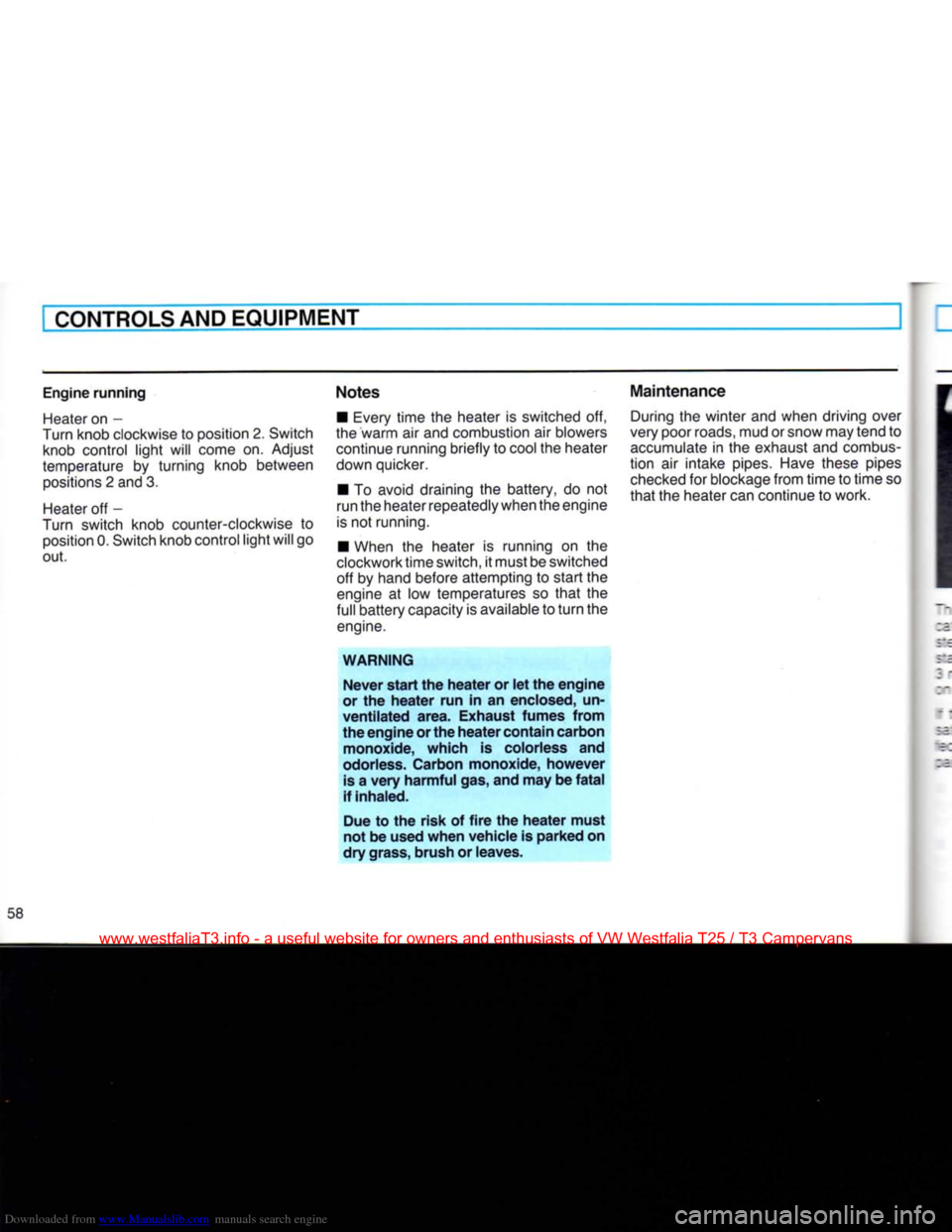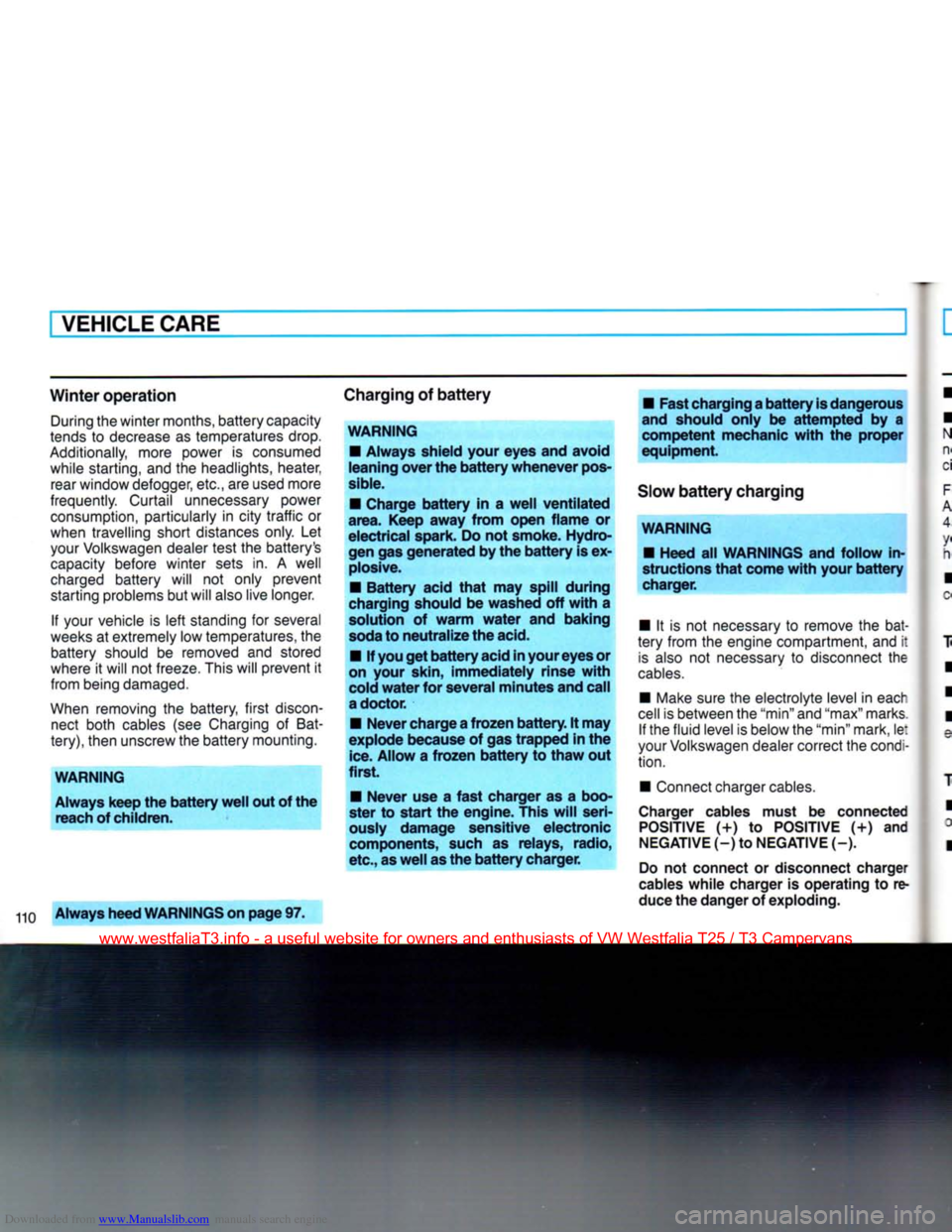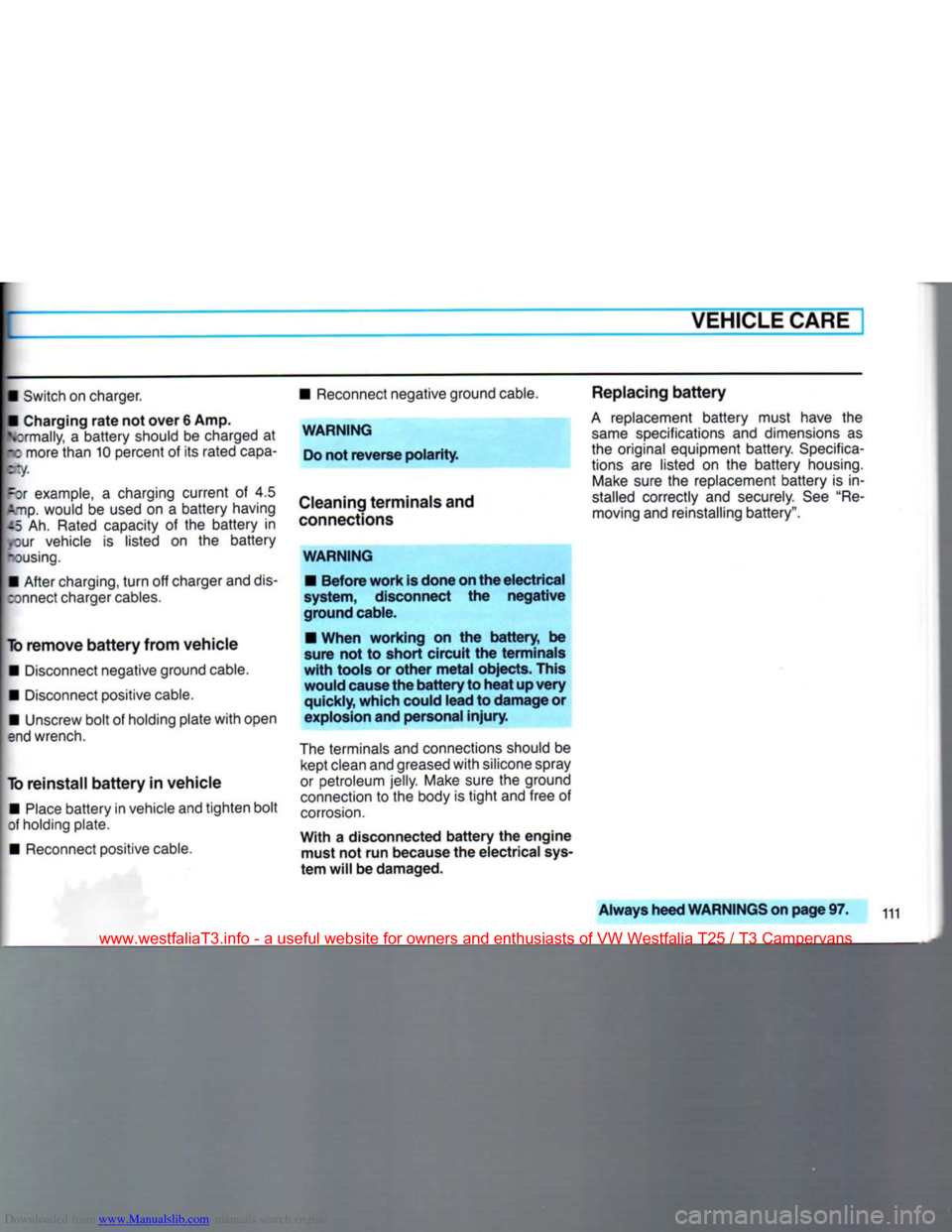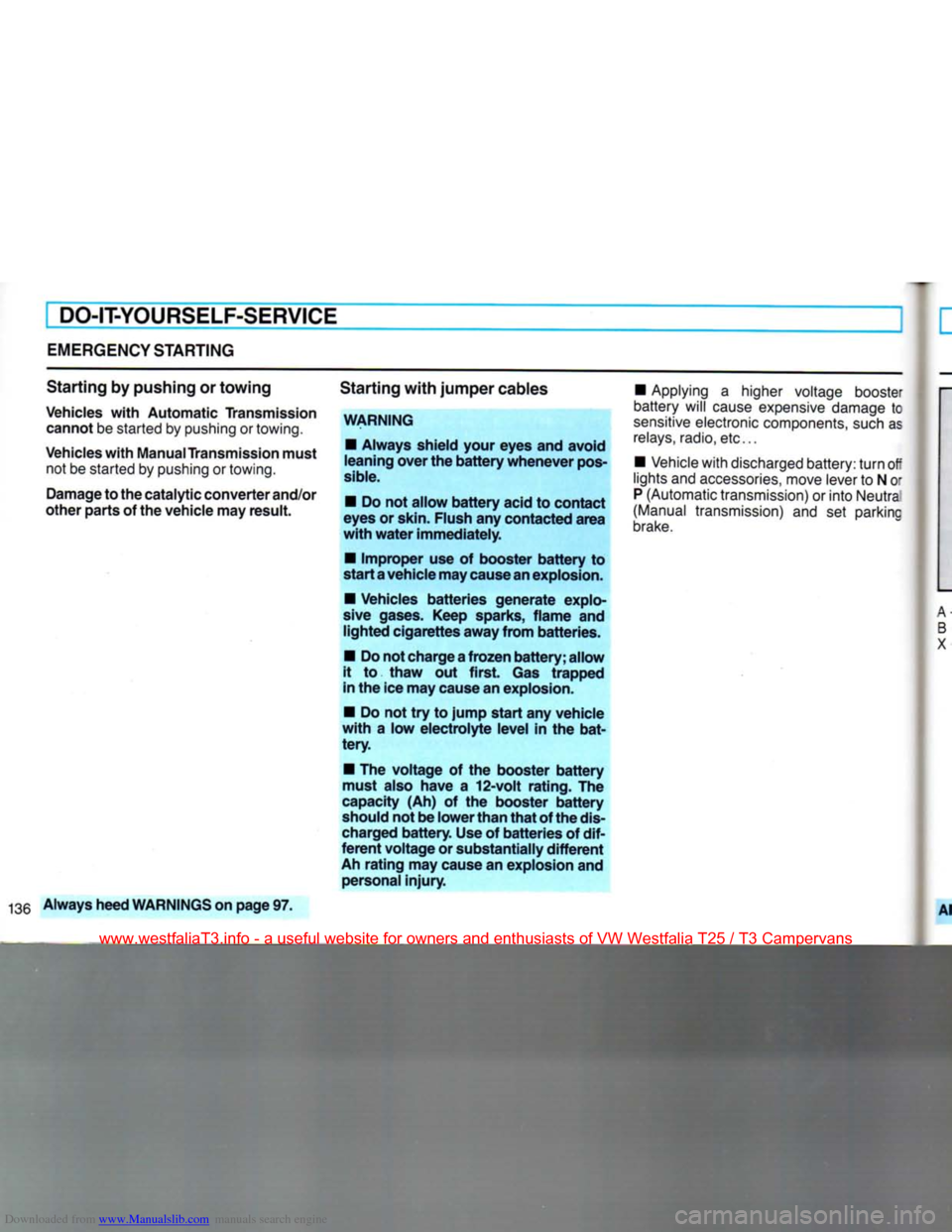1990 VOLKSWAGEN TRANSPORTER battery capacity
[x] Cancel search: battery capacityPage 59 of 165

Downloaded from www.Manualslib.com manuals search engine
CONTROLS AND EQUIPMENT
Engine
running
Heater
on -
Turn knob clockwise to position 2. Switch knob control light will come on. Adjust
temperature by turning knob between positions 2 and 3.
Heater
off -
Turn switch knob counter-clockwise to position 0. Switch knob control light will go
out.
Notes
• Every time the heater is switched off,
the warm air and combustion air blowers continue running briefly to cool the heater
down quicker.
• To avoid draining the battery, do not
run the heater repeatedly when the engine
is
not running.
• When the heater is running on the
clockwork time switch, it must be switched
off by hand before attempting to start the
engine at low temperatures so
that
the
full
battery capacity is available to
turn
the
engine.
WARNING
Never
start
the
heater
or let the
engine
or the
heater
run in an enclosed, un-
ventilated
area.
Exhaust
fumes
from
the
engine
or the
heater
contain
carbon monoxide,
which
is colorless and
odorless. Carbon monoxide,
however
is a
very
harmful
gas, and may be
fatal
if inhaled.
Due to the
risk
of
fire
the
heater
must
not be used
when
vehicle
is
parked
on
dry grass, brush or leaves.
Maintenance
During the winter and when driving over
very poor roads, mud or snow may tend to
accumulate
in the exhaust and combus
tion air intake pipes. Have these pipes
checked
for blockage from time to time so
that
the heater can continue to work.
58
www.westfaliaT3.info - a useful website for owners and enthusiasts of VW Westfalia T25 / T3 Campervans
Page 115 of 165

Downloaded from www.Manualslib.com manuals search engine
VEHICLE
CARE
Winter operation During the winter months, battery capacity
tends to decrease as temperatures drop.
Additionally, more power is consumed while starting, and the headlights, heater, rear window defogger, etc., are used more
frequently. Curtail unnecessary power
consumption,
particularly in city traffic or
when travelling short distances only. Let
your
Volkswagen dealer test the battery's
capacity before winter sets in. A well
charged battery will not only prevent
starting
problems but will also live longer.
If
your
vehicle is left standing for several
weeks
at extremely low temperatures, the battery should be removed and stored
where it will not freeze.
This
will prevent it
from being damaged.
When removing the battery, first discon nect both cables (see Charging of Bat
tery),
then unscrew the battery mounting.
WARNING
Always keep the battery well out of the reach of children.
Always heed WARNINGS on page
97.
Charging of battery
WARNING
•
Always shield
your
eyes and avoid
leaning
over
the battery whenever pos
sible.
•
Charge battery in a well ventilated
area.
Keep away from open flame or
electrical
spark. Do not
smoke.
Hydro gen gas generated by the battery is explosive.
•
Battery acid that may spill during
charging should be washed off with a solution of warm water and baking
soda
to neutralize the
acid.
•
If you get battery
acid
in
your
eyes or
on
your
skin,
immediately rinse with
cold
water for several minutes and
call
a
doctor.
•
Never charge
a
frozen battery. It may
explode because of gas trapped in the
ice.
Allow a frozen battery to thaw out
first.
•
Never use a fast charger as a boo
ster to start the engine.
This
will
seri
ously damage sensitive electronic
components,
such as relays, radio,
etc.,
as well as the battery charger.
•
Fast charging
a
battery
is
dangerous
and should only be attempted by a
competent mechanic with the proper
equipment.
Slow battery charging WARNING
•
Heed all WARNINGS and follow in
structions that come with
your
battery
•
It is not necessary to remove the bat
tery
from the engine compartment, and it
is
also not necessary to disconnect the
cables.
•
Make sure the electrolyte level in each
cell
is between the "min" and "max" marks. If the fluid level is below the "min" mark, le:
your
Volkswagen dealer correct the condi
tion.
•
Connect charger cables.
Charger cables must be connected
POSITIVE
(+) to
POSITIVE
(+) and
NEGATIVE
(-) to
NEGATIVE
(-).
Do not connect or disconnect charger
cables
while charger is operating to re
duce the danger of exploding.
www.westfaliaT3.info - a useful website for owners and enthusiasts of VW Westfalia T25 / T3 Campervans
Page 116 of 165

Downloaded from www.Manualslib.com manuals search engine VEHICLE CARE
• Switch on charger.
• Charging
rate
not over 6 Amp.
Vormally,
a battery should be charged at
rc more than 10 percent of its rated
capa
city.
For
example, a charging current of 4.5
Amp.
would be used on a battery having
• Ah. Rated capacity of the battery in .our vehicle is listed on the battery
"Dusing.
• After charging,
turn
off charger and dis-
ronnect charger
cables.
To
remove
battery
from
vehicle • Disconnect negative ground cable.
• Disconnect positive cable.
• Unscrew bolt of holding plate with open
end
wrench.
To
reinstall
battery
in vehicle •
Place
battery in vehicle and tighten bolt
of holding plate.
• Reconnect positive cable. • Reconnect negative ground cable.
WARNING
Do not
reverse
polarity.
Cleaning
terminals
and
connections
WARNING
• Before
work
is done on the
electrical
system, disconnect the
negative
ground cable.
•
When
working
on the
battery,
be
sure not to short circuit the
terminals
with
tools or
other
metal
objects. This
would
cause the
battery
to
heat
up
very
quickly,
which
could
lead
to
damage
or
explosion and personal
injury.
The
terminals and connections should be kept clean and greased with silicone spray
or
petroleum jelly. Make sure the ground
connection
to the body is
tight
and free of
corrosion.
With
a disconnected
battery
the
engine
must
not run because the
electrical
sys
tem
will
be damaged. Replacing
battery
A
replacement battery must have the
same
specifications and dimensions as
the original equipment battery.
Specifica
tions are listed on the battery housing.
Make
sure the replacement battery is in
stalled
correctly and securely. See "Re moving and reinstalling battery".
Always heed
WARNINGS
on
page
97.
www.westfaliaT3.info - a useful website for owners and enthusiasts of VW Westfalia T25 / T3 Campervans
Page 141 of 165

Downloaded from www.Manualslib.com manuals search engine
DO-IT-YOURSELF-SERVICE
EMERGENCY
STARTING
Starting by
pushing
or towing
Vehicles
with
Automatic Transmission
cannot
be started by
pushing
or
towing.
Vehicles
with
Manual
Transmission
must
not
be started by
pushing
or
towing.
Damage to the catalytic converter and/or
other parts of the vehicle may result. Starting
with
jumper
cables
WARNING
•
Always shield your eyes and avoid
leaning over the battery whenever
pos
sible.
•
Do not allow battery acid to contact
eyes
or
skin.
Flush any contacted area
with
water
immediately.
•
Improper use of booster battery to
start a vehicle may
cause
an
explosion.
•
Vehicles batteries generate explo
sive
gases.
Keep sparks, flame and lighted cigarettes away from batteries.
•
Do not charge a frozen battery; allow
it to thaw out first. Gas trapped
in the ice may cause an explosion.
•
Do not try to jump start any vehicle
with
a low electrolyte level in the bat tery.
•
The voltage of the booster battery
must also have a 12-volt rating. The
capacity
(Ah) of the booster battery
should
not be lower than
that
of the
dis
charged
battery. Use of batteries of dif
ferent voltage or substantially different
Ah
rating may cause an explosion and
personal
injury.
•
Applying
a
higher
voltage
booster
battery
will
cause
expensive
damage
tc
sensitive
electronic
components,
such
as
relays,
radio,
etc...
•
Vehicle
with
discharged
battery: turn off
lights
and
accessories,
move
lever
to N or
P
(Automatic
transmission)
or into
Neutra
(Manual
transmission)
and set
parking
brake.
Always
heed WARNINGS on page 97.
www.westfaliaT3.info - a useful website for owners and enthusiasts of VW Westfalia T25 / T3 Campervans
Page 161 of 165

Downloaded from www.Manualslib.com manuals search engine
GAS
STATION
INFORMATION
1 -
Jack
and tools, see page 123.
2
- Windshield washer container, capacity 4.3 qt/4.2 liters.
3
-
Fuse
box, see page 128.
4 - Brake
fluid
reservoir, see page 108.
5
- Spare wheel, see page 124.
6 - Battery, see page 109.
7 -
Fuel
filler neck (rear wheel drive), capacity 16 gal/60 liters.
8 -
Rear
window washer container, capacity 1.1 qt/1.0 liters.
9 -
Fuel
filler neck (syncro), capacity 18.5 gal/70 liters.
10 - Air cleaner, see page 103.
11 - Power steering
fluid
reservoir, see page 103.
12 - Engine oil dipstick/oil filler neck, see page 99.
13
- Coolant
refill
tank, see page 105.
14 - ATF dipstick, see page 102.
157
www.westfaliaT3.info - a useful website for owners and enthusiasts of VW Westfalia T25 / T3 Campervans